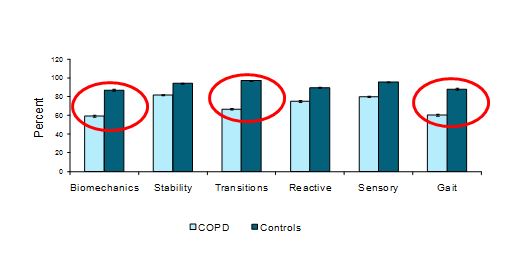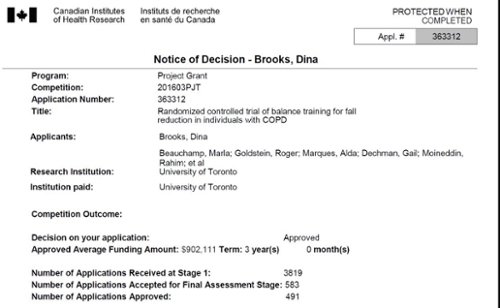Brooks D 1,2, Harrison S.L 3
1 The Department of Respiratory Medicine, West Park Healthcare Centre; Toronto, Ontario, Canada
2 Department of Physical Therapy, University of Toronto, Toronto, ON, Canada.
3 Health and Social Care Institute, School of Health and Social Care, Teesside University, Middleborough, UK.
Breathlessness is the prevailing symptom in Chronic Obstructive Pulmonary Disease (COPD), although recently these individuals have been found to be at a higher risk of falling 1-3. In two prospective studies the annual falls rate in COPD was 3-5 times higher than that observed in healthy adults of a similar age 2,3 and in a recent analysis involving more than 16,000 older Canadians, COPD was the only chronic condition that predicted falls 4. Fall-related injuries are common in COPD resulting in increased hospitalisation 5,6and in those with severe COPD a history of falling is a strong predictor of mortality 7.
Poor balance is a major risk factor for falls. Balance impairments have been confirmed in individuals with COPD using both laboratory and clinical based measures 8,9. The components of balance most affected include biomechanics (strength, range of motion, posture), transitions (change in body positions) and gait (stability whist walking) 8.
Figure 1: Scores on each of the components of the Balance Evaluation Systems Test in subjects with COPD vs control subjects (all comparisons were significant at P < .001)

Beauchamp MK, Sibley KM, Lakhani B, et al. Impairments in Systems Underlying Control of Balance in COPD. Chest.141(6):1496-1503.
As with other secondary effects of the disease, following an acute exacerbation of COPD (AECOPD) impairments in balance control appear to be elevated 9,10. We have just completed a small prospective study that demonstrates a decline in balance performance, which is still evident one month following an AECOPD 11.
Pulmonary Rehabilitation (PR) is recommended for all individuals with COPD and has been shown to unequivocally improve exercise capacity 12 although only minor improvements are conferred in terms of balance control 13. This is perhaps unsurprising as currently specific balance training is not included in international guidelines for PR, and yet PR offers a convenient setting in which to deliver exercise with balance training in accordance with falls prevention strategies for older adults 14.
A randomised controlled trial demonstrates that individualised balance training, targeting balance deficits specifically identified in people with COPD (biomechanics, transitions and gait), and delivered alongside PR leads to clinically meaningful improvements in balance performance15. These results have since been supported in a European population 16. Furthermore, balance training has been successfully implemented into an existing PR program and found to be feasible, effective and sustainable even at six months follow up17.
Although we know that balance training improves balance performance measures, the important question remains: does balance training in individuals with COPD decrease falls? In 2015, we applied to the Canadian Institute for Health Research (CIHR), the largest granting agency in Canada for funding, for a project entitled: “Randomized controlled trial (RCT) of balance training for fall reduction in individuals with COPD”. The main purpose of this study was to investigate the effect of a balance-training program on falls in patients with COPD enrolled in PR. We estimated that we needed 329 patients to be appropriately powered to detect a difference in falls and participants would be recruited from nine sites internationally. Patients with COPD with a self-reported decline in balance and/or fall in the last two years and/or recent near fall would be assigned randomly to an intervention or control group. The intervention group would undergo balance training in addition to PR and the control group would receive only standardized PR (without balance training). Falls at 12 months were documented using monthly calendars. Falls were defined as “an incident in which the body unintentionally comes to rest on the ground or other lower level which is not as a result of a violent blow, loss of consciousness, sudden onset of paralysis as in a stroke or an epileptic seizure” 17. In addition, measures of balance and strength were recorded.
Funding rates are less than 15% for CIHR. In 2015 our grant scored too low for funding. We addressed the concerns of the reviewers, including an economic analysis component and a more detail sample size calculation and data analysis section, reapplied in 2016 and received funding.

Over the last year, there have been many hurdles to climb inherent to performing a multi-centered international RCT. We have employed a research coordinator, applied and received ethics at all nine sites (three in Australia, two in Europe and four in Canada), finalized financial agreements and data sharing agreements, hired two staff at each site for the intervention and outcome assessment and bought balance training equipment for each site. Data collection has started at most of the sites. The protocol for the study has been published and we expect results in 2019 18.
References
- Beauchamp MK, Hill K, Goldstein RS, Janaudis-Ferreira T, Brooks D. Impairments in balance discriminate fallers from non-fallers in COPD. Respiratory Medicine. 2009;103(12):1885.
- Oliveira CC, McGinley J, Lee AL, Irving LB, Denehy L. Fear of falling in people with chronic obstructive pulmonary disease. Respiratory Medicine. 2015;109(4):483-489.
- Roig M, Eng JJ, MacIntyre DL, et al. Falls in people with chronic obstructive pulmonary disease: an observational cohort study. Respiratory Medicine. 2011;105(3):461-469.
- Sibley KM, Voth J, Munce SE, Straus SE, Jaglal SB. Chronic disease and falls in community-dwelling Canadians over 65 years old: a population-based study exploring associations with number and pattern of chronic conditions. BMC Geriatrics. 2014;14(1):22.
- Lee YJ, Boyd AD, Li JJ, et al. COPD Hospitalization Risk Increased with Distinct Patterns of Multiple Systems Comorbidities Unveiled by Network Modeling. AMIA ... Annual Symposium proceedings. AMIA Symposium. 2014;2014:855-864.
- Jørgensen TSH, Hansen AH, Sahlberg M, et al. Nationwide time trends and risk factors for in-hospital falls-related major injuries. International Journal of Clinical Practice. 2015;69(6):703-709.
- Yohannes AM, Raue PJ, Kanellopoulos D, et al. Predictors of All-Cause Mortality in Patients With Severe COPD and Major Depression Admitted to a Rehabilitation Hospital. Chest. 2016;149(2):467-473.
- Beauchamp MK, Sibley KM, Lakhani B, et al. Impairments in Systems Underlying Control of Balance in COPD. Chest.141(6):1496-1503.
- Crişan AF, Oancea C, Timar B, Fira-Mladinescu O, Tudorache V. Balance impairment in patients with COPD. Plos One. 2015;10(3):e0120573-e0120573.
- Oliveira CC, Lee AL, McGinley J, et al. Balance and Falls in Acute Exacerbation of Chronic Obstructive Pulmonary Disease: A Prospective Study. Copd. 2017;14(5):518-525.
- Puhan MA, Gimeno-Santos E, Cates CJ, Troosters T. Pulmonary rehabilitation following exacerbations of chronic obstructive pulmonary disease. The Cochrane database of systematic reviews. 2016;12:Cd005305.
- Beauchamp MK, O'Hoski S, Goldstein RS, Brooks D. Effect of pulmonary rehabilitation on balance in persons with chronic obstructive pulmonary disease. Arch Phys Med Rehabil. 2010;91(9):1460-1465.
- Guideline for the prevention of falls in older persons. American Geriatrics Society, British Geriatrics Society, and American Academy of Orthopaedic Surgeons Panel on Falls Prevention. Journal of the American Geriatrics Society. 2001;49(5):664-672.
- Beauchamp MK, Janaudis-Ferreira T, Parreira V, Romano JM, Woon L, Goldstein RS. A randomized controlled trial of balance training during pulmonary rehabilitation for individuals with COPD. Chest. 2014;144.
- Marques A, Jácome C, Cruz J, Gabriel R, Figueiredo D. Effects of a Pulmonary Rehabilitation Program With Balance Training on Patients With COPD. Journal of cardiopulmonary rehabilitation and prevention. 2015;35(2):154-158.
- Harrison SL, Beauchamp MK, Sibley K, et al. Minimizing the evidence-practice gap – a prospective cohort study incorporating balance training into pulmonary rehabilitation for individuals with chronic obstructive pulmonary disease. BMC Pulmonary Medicine. 2015;15(1):73.
- The prevention of falls in later life. A report of the Kellogg International Work Group on the Prevention of Falls by the Elderly. Danish medical bulletin. 1987;34 Suppl 4:1-24.
- Beauchamp MK, Brooks D, Ellerton C et al. Pulmonary Rehabiltation with balance training for fall reduction in chronci obstructive pulmonary disease,: Protoco, for a randomized controlled trial. JMIR Res Protoc 2017;6(11):e228.



